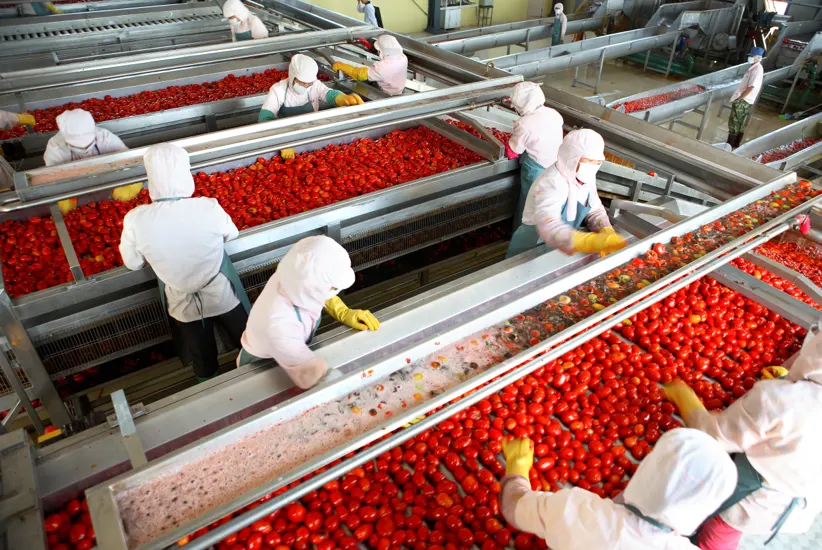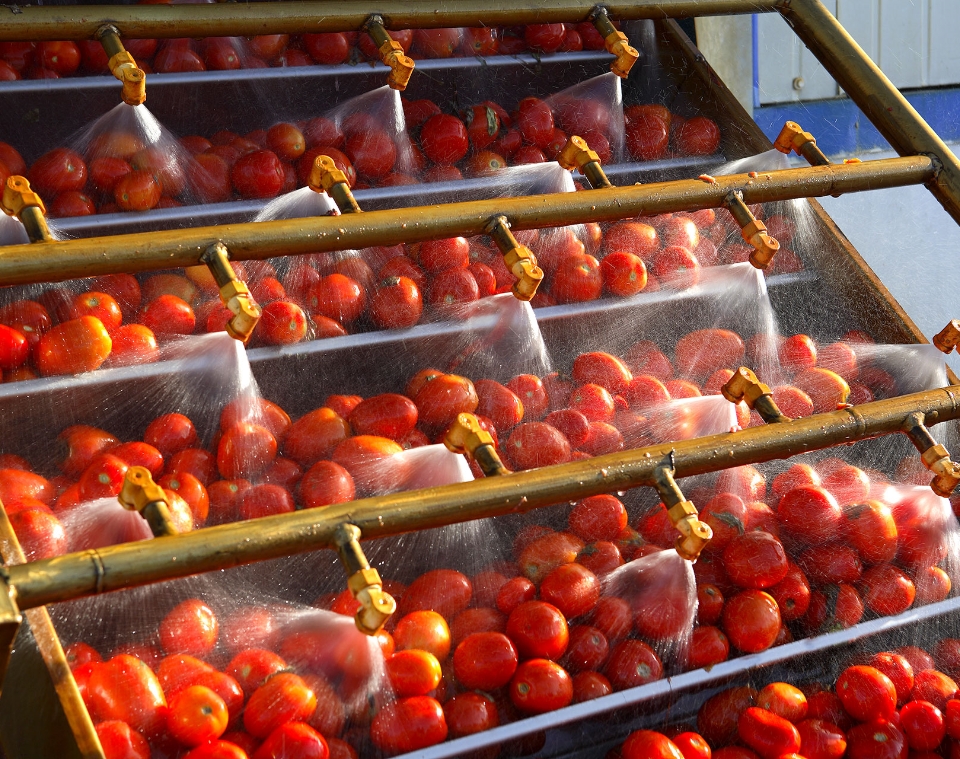Tomato processors face the daily challenge of balancing quality and output. Brix consistency and yield efficiency are key metrics but often conflict. This article explains their roles, impact, and how technology and automation can help optimize both for better profitability and product quality.
Understanding Brix in Tomato Processing
Brix is a measurement of the soluble solids content in a liquid, expressed as a percentage. In tomato processing, Brix refers primarily to natural sugars, organic acids, and other soluble solids in tomato juice or paste.
For tomato paste and related products, specific Brix levels determine product classification:
- Cold Break Paste: 28–30° Brix
- Hot Break Paste: 30–32° Brix
- Concentrated Paste: Up to 36–38° Brix
- Tomato Juice and Ketchup: Typically lower, 5–12° Brix
Maintaining consistent Brix is essential for product quality, labeling compliance, and consumer satisfaction. Any fluctuations can lead to rejection by clients or costly reprocessing.
What Is Yield Efficiency?
Yield efficiency is the amount of finished product generated from a given quantity of raw tomatoes. Expressed as a percentage, it compares theoretical yield (based on tomato composition) to actual production output.
Factors affecting yield include:
- Tomato variety and ripeness
- Processing method (cold break vs. hot break)
- Evaporation and filtration efficiency
- Losses during peeling, pulping, or deaeration
- Equipment calibration and operator skill
Maximizing yield efficiency is crucial to reducing costs and increasing profit margins, especially given the rising price of raw agricultural inputs.

Why Brix Consistency and Yield Efficiency Sometimes Conflict
While both metrics are vital, they can be inversely related. Here’s how:
- Increasing Brix through longer evaporation or over-concentration can reduce final yield by burning off water content and even some solids.
- Pushing for maximum yield may involve extracting every possible drop from tomatoes, which can dilute the product or compromise Brix consistency.
Therefore, tomato processors must carefully control inputs and processing parameters to optimize one without jeopardizing the other.
How Brix Consistency Affects Final Product Quality
Regulatory Compliance
Many countries and buyers set strict Brix specifications for tomato paste and sauces. Deviations can lead to failed quality audits or product recalls.
Sensory Attributes
Fluctuations in Brix affect flavor, color, and mouthfeel. Too low, and the paste is watery and bland; too high, and it may taste overly sweet or thick.
Standardization Across Batches
Inconsistent Brix levels make it hard to blend batches or scale production, especially for products like ketchup, where uniformity is key.
How Yield Efficiency Impacts Profitability
Raw Material Utilization
Tomatoes are expensive and perishable. Higher yield means getting more paste per ton of tomatoes, directly improving ROI.
Lower Waste Generation
Efficient use of pulp, skin, and seeds reduces organic waste and cuts disposal costs.
Energy and Water Savings
More efficient yield means less energy spent on evaporation per unit of finished product. This supports sustainability targets and cuts utility bills.
Factors That Influence Brix and Yield
| Factor | Brix Consistency Impact | Yield Efficiency Impact |
| Tomato Ripeness | High ripeness ensures higher Brix | Overripeness can lead to higher losses |
| Break Type (Hot vs Cold) | Hot break stabilizes pectin (more viscous) | Cold break retains more flavor |
| Evaporation Temperature | Higher temp increases Brix faster | Too high may reduce the overall yield |
| Pulping Efficiency | Finer mesh may increase solids in juice | Poor pulping causes more waste |
| Equipment Maintenance | Calibrated systems maintain control | Malfunctioning parts reduce throughput |
| Operator Skill | Consistent monitoring ensures uniformity | Skilled operators maximize throughput |
The Role of Automation in Achieving Balance
Modern tomato processing lines use automation to monitor and control both Brix and yield. Key technologies include:
Inline Brix Sensors
Installed in evaporators and mixing tanks, these devices measure Brix in real time using refractometry or near-infrared (NIR) spectroscopy. They enable:
- Immediate corrective action
- Reduced manual sampling
- Continuous quality assurance
Mass Flow Meters and Yield Calculators
These systems track the volume of tomatoes input and the weight/volume of output. Yield efficiency software then calculates performance against theoretical yield.
SCADA (Systems for Supervisory Control and Data Acquisition)
SCADA platforms collect data from sensors, valves, and controls across the entire line. They allow operators to:
- Monitor both Brix and yield dashboards
- Set alarms for deviations
- Optimize evaporation rates and pulping pressure
Best Practices to Balance Brix and Yield
Raw Material Segregation
Different tomato varieties have different Brix levels. Processing them separately allows for tailored settings that reduce variability and waste.
Controlled Evaporation Stages
Rather than relying on aggressive single-stage evaporation, multi-effect evaporators allow better control over Brix concentration without sacrificing yield.
Regular Calibration of Sensors
Brix meters and flow devices need regular maintenance to stay accurate. Slight drift in readings can cause major quality or cost issues over time.
Use of Enzymes in Cold Break
In cold break systems, enzymes can help break down pectin and increase juice yield while preserving flavor, supporting both metrics.
Operator Training Programs
Well-trained operators can respond quickly to process fluctuations and optimize line parameters based on real-time data.
Case Study: 30-32° Brix Tomato Paste Production
One of our previous clients, a processor of 30-32° Brix hot-crushed tomato paste, was facing challenges with fluctuating Brix readings and low yields during peak season.
Problem:
Inconsistent tomato ripeness and inefficient pulping resulted in yields below 85%, with Brix often below specification.
Solution:
We designed and installed an online Brix sensor and automatic pulper pressure regulator in two phases, as well as calibrated flow meters to better track yields. Once installed, we trained staff on how to set the optimal evaporation time
Results:
Brix deviation reduced to within ±0.5°
Yield increased by 6%
Energy consumption reduced by 9%
Industry Benchmarks for Brix and Yield
| Product Type | Ideal Brix Level | Typical Yield Efficiency |
| Cold Break Paste | 28–30° Brix | 90–92% |
| Hot Break Paste | 30–32° Brix | 88–91% |
| Tomato Juice | 5–7° Brix | 95%+ |
| Ketchup Base | 12–15° Brix | 93–95% |
| Concentrated Paste | 36–38° Brix | 85–88% |
Balancing Brix consistency and yield efficiency is key to quality and profitability in tomato processing. With proper technology and control, both goals can be achieved. From small ketchup lines to large paste plants, optimizing these KPIs boosts production. Automation and real-time monitoring now make it possible to ensure product consistency while maximizing returns.


